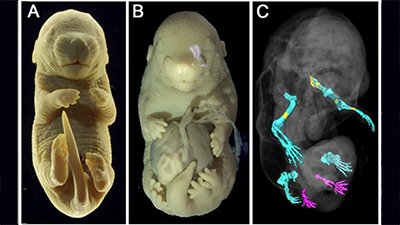DNA Day: What Are We Celebrating?
We’ve recently seen something of a bombardment of declared holidays and observances. In the midst of all these pseudo-holidays is one that has a particular relevance today: National DNA Day.
Here in the United States we’ve recently seen something of a bombardment of declared holidays and observances: things like Law Day, National Defense Transportation Day, and Arbor Day. In the midst of all these pseudo-holidays is one that has a particular relevance today: National DNA Day.
A Brief History of DNA Day
National DNA Day was initially introduced via resolutions from the United States Senate1 and House of Representatives.2 Though the Senate and House only observed the day on April 23, 2003, the National Human Genome Research Institute (NHGRI) and other groups have pushed for the annual observance of DNA Day. According to the NHGRI website, “National DNA Day commemorates the successful completion of the Human Genome Project in 2003 and the discovery of DNA’s double helix by James Watson and Francis Crick in 1953. This annual celebration offers students, teachers and the public many exciting opportunities to learn about the latest advances in genomic research and explore what they may mean for their lives.”3
It is worth noting that Watson and Crick—both outspoken about their disbelief of God—were motivated to study and comprehend DNA out of an eagerness to see faith in God and belief in His Word undermined.4 You see, what Watson and Crick desired to discover in DNA was a way to explain how life could have come about apart from the involvement of God. Truly, they sought for an empirical confirmation of their presupposition that no Creator God exists—although Romans 1:18–25 reveals that there are really no true atheists because God’s “invisible attributes are clearly seen, being understood by the things that are made.” So they are “without excuse” in their atheism, which is essentially neo-paganism—worship of creation rather than the Creator.
Evolution and Paganism
Perhaps here it is profitable to note that paganism’s primary unifying principle is the belief that, ultimately, anything can transform into anything else; that the universe is infinitely malleable. All that is really needed are principle constituents (whose origins are either presumed infinite or are not explained) plus time and tumult.
In cosmic evolution, the principle element—the substance that supposedly makes anything possible—is generally considered to be hydrogen. Hydrogen is a light, colorless, odorless gas, which, given enough time, supposedly turns into fireflies, cheesecake, human beings, and so on. So, in striking similarity to other pagan myths, evolutionary cosmologists largely insist that everything that exists has come about from a bit of hydrogen, a pinch of incomprehensible time, and the requisite cosmic agitations.
Likewise, in biological evolution, the principle element is DNA. Consistent with their pagan assumptions, evolutionary biologists insist that one type of organism can morph into another completely different type of organism through the modification of DNA over successive generations via the main catalysts of natural selection and mutation. In other words: principle constituents, plus time, plus tumult. But is it really that simple?
The Complex Language of DNA
The problem with this idea is that DNA is far more complex and elegant than the above scenario would lead you to think. In fact, even in documenting most of the human genome we’ve only scratched the surface of what there is to know about this wonderful molecule. DNA isn’t just a code like, “I-N-T-H-E-B-E-G-I-N-N-I-N-G-W-A-S-T-H-E-W-O-R-D,” where simple bits of data are merely transcribed and copied and modified. DNA and its supporting systems operate more like what just happened when you took in the information of that code, looked for a recognizable pattern, broke it down in your mind, properly established the code as familiar English words (while simultaneously eliminating other possibilities), comprehended that the code had an intentional meaning, comprehended what that meaning was, made an accurate copy by committing it to memory, and perhaps even responded physically in some way.
That is what DNA is like: it’s a complex language; it’s poetry. Besides, even if DNA were merely a code, codes only make sense within a construct of intelligence. Codes must be read, they must be understood, and then they must be acted upon. So, just as life only comes from life, information only comes from information. DNA is not the random result of physical laws acting on matter, but neither is it just the practical product of an intelligent being. DNA is the result of an artist—the Artist. Truly, this molecule is arrayed in a way that displays the signature of the triune God.
Perhaps it was these intricacies of DNA that drove Crick toward explaining the origin of life on earth in other terms. In 1981, Crick wrote a book arguing that life on earth actually originated as the intentional, creative acts of extraterrestrial beings:
In this book I explore a variant of panspermia which Leslie Orgel and I suggested a few years ago. To avoid damage, the microorganisms are supposed to have traveled in the head of an unmanned spaceship sent to earth by a higher civilization which had developed elsewhere some billions of years ago. The spaceship was unmanned so that its range would be as great as possible. Life started here when these organisms were dropped into the primitive ocean and began to multiply. We called our idea Directed Panspermia.5
Later in the book, Crick wrote the following:
The kindest thing to state about Directed Panspermia, then, is to concede that it is indeed a valid scientific theory, but that as a theory it is premature. This inevitably leads to the question, will its time ever come? And here we must tread cautiously. The history of science shows that it is all too easy to state, with the best of scientific reasons, that such and such will never be discovered or that so and so will never be done. … What is striking is how short a time it took to upset these negative prophecies.6
At first glance, the position Crick is advancing seems conspicuously convenient. But it is worth noting that not only is Crick insulting his readers’ intelligence, but what he has written here is also entirely counterproductive. Consider this: what is more problematic than explaining the existence of an advanced race of intelligent life? Explaining the existence of an even more advanced race of intelligent life. In other words, even if we were to accept Crick’s ridiculous proposal, how do we explain the origin of our alien superiors? The answer is that we cannot reasonably explain it, and proponents of this idea would rather us pay no heed to that particular man behind the curtains.
What Does DNA Day Mean for Believers?
So where does this leave us, Christians? First, give thanks to God that we don’t have to guess about our origins—and we don’t have to make up science fiction tales and then convince ourselves or others that they’re true. We are told what happened by the One who made all things—things whose continued existence is dependent upon “the word of His power
” (Hebrews 1:3). Of course, herein lies a great irony—a problem that mercilessly plagues every effort to provide an exclusively materialistic explanation for the existence of the universe and all that it contains: Watson and Crick were in reality attempting to disprove the existence of God by striving to understand the tangible products of His creative and sustaining words. Put another way, these men were trying to use the proof of God’s existence as proof that He doesn’t exist. This is nothing short of madness—but anticipated madness (Psalm 14:1; Proverbs 1:7; 18:2). Those who walk by sight are actually blind, while those who walk by faith can truly see (2 Corinthians 5:7).
Second, on this day let’s be careful not to honor merely the structure of DNA because that would ultimately miss the point of DNA. A sequence of DNA exists for the same reason that the entity it codes for exists: to bring glory to the God who made it (Colossians 1:16). In other words, we clearly see from our DNA that we have a Maker, in whom “we live and move and have our being
” (Acts 17:28). For this, too, we ought to be thankful.
Footnotes
- http://www.genome.gov/11008128
- http://www.genome.gov/11008129
- http://www.genome.gov/26525485
- In 1988, Crick wrote, “I realized early on that it is detailed scientific knowledge which makes certain religious beliefs untenable. A knowledge of the true age of the earth and of the fossil record makes it impossible for any balanced intellect to believe in the literal truth of every part of the Bible in the way that fundamentalists do. And if some of the Bible is manifestly wrong, why should any of the rest of it be accepted automatically? … What could be more foolish than to base one’s entire view of life on ideas that, however plausible at the time, now appear to be quite erroneous? And what would be more important than to find our true place in the universe by removing one by one these unfortunate vestiges of earlier beliefs?” Francis Crick, What Mad Pursuit: a Personal View of Scientific Discovery (Basic Books reprint edition, 1990), p. 11.
- Francis Crick, Life Itself: Its Origin and Nature (New York: Simon and Schuster, 1981), p. 16.
- Ibid, p. 153.
Recommended Resources

Answers in Genesis is an apologetics ministry, dedicated to helping Christians defend their faith and proclaim the good news of Jesus Christ.
- Customer Service 800.778.3390
- © 2025 Answers in Genesis






